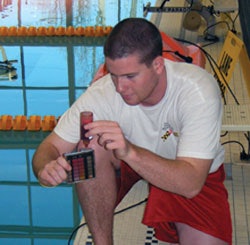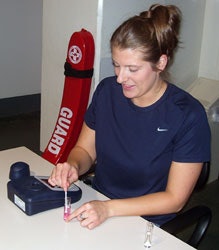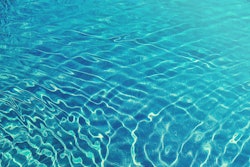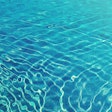Pool chemistry testing equipment tends to absorb most of the blame for false readings, despite the fallibility of people who handle it.

For many pool-care professionals, Antoniou's amazement translates into job-related anxiety. False water readings - and subsequently imbalanced water - can cause a variety of operational problems. It can corrode a pool's structure or equipment; it can cause water to appear cloudy or discolored; it can violate government regulations, potentially causing a facility to be shut down; and, worst of all, it can facilitate the spread of dangerous bacteria that can cause illness in pool users, and even death.
All this because of faulty kits? In many cases, probably not. What's more likely to be behind such gross misreadings, says Antoniou, is some indeterminate combination of factors related to human error or just plain human variability (individual differences in color perception in tests relying on a color comparator, for example.)
In fact, color perception was the defense used by several leading test kit manufacturers after the release of a 2005 study by researchers at California Polytechnic State University's National Pool Industry Research Center. Much like Antoniou's informal research at the Utah hotel, the NPIRC study focused on different types of kits from multiple manufacturers, and "strongly indicated significant differences among the test kits when measuring pH, total alkalinity and calcium hardness level concentrations," with alkalinity readings varying by percentages in the hundreds, according to the study's authors. In their defense, several manufacturers released a statement suggesting too many variables were uncontrolled for the data to be reliable. "For instance, a number of tests involve color matching. Do the researchers know for certain that the people performing the tests have the same ability to perceive colors?" they asked.
Antoniou takes the color-perception defense a step further. "A manufacturer's instructions may say to hold your water sample up to the northern light," he says. "Well, what happens if it's a cloudy day? What if I am at an indoor facility and it is freezing outside? Am I supposed to go outside to find the northern light?"
Though color perception applies only to certain kit types, it nonetheless is one of the myriad ways in which human operation can throw off test results, regardless of whether simple colorimetric kits or highly accurate (and highly priced) electronic devices are used. Thus, pool operators are well served to learn the strengths and limitations of their specific kit types, and, more specifically, to learn how the improper handling of even the most exacting kits can skew results.
Naturally, not all pool water testing equipment is created equal, and testing technology has allowed for a variety of digital products that experts tend to agree produce highly accurate results. Most pool test equipment manufacturers now offer portable digital photometers, which effectively remove the problematic human element of color comparison from the testing process.
For what's called colorimetric DPD testing, digital or otherwise, reagents are mixed with water samples. When the chemical or residual being tested for is present, a color change results, from transparent to, say, a shade of pink. With non-digital testing equipment, the resulting color is then matched up against a color comparator, usually in the form of a color chart either on the vial casing or as a separate component of the kit (a color wheel, for example). Enter the human element, as the test's conductor must match the color of the sample to its closest likeness on the comparator. As Antoniou points out, most manual color comparators involve the placement of a specific color shade next to a corresponding ppm value. That can be limiting, he says, since the standardized color variations can be slight to the human eye but representative of significant changes in a measurement. For example, a comparator may show one shade for 4 ppm, with the next, slightly darker shade representing 5 ppm. "You end up saying, 'Well, the sample is not quite as light as the 4, but it's not quite as dark as the 5, so what is it?' " says Antoniou. "People tend to say it's about a 4.5, but some subtle differences like that can make a big difference in your water chemistry."
Most digital photometers don't require such approximation, as the vial is inserted into the cavity of the machine, creating a controlled environment devoid of external light. A beam of light is then passed through the sample, and the photometer provides a reading of the test results on a display screen within seconds. For those operators using manual colorimeters, University of Maryland aquatics director Carrie Tupper recommends training staff to hold the water sample up against the same background - a backstroke flag, for example - each time a test is run.
Operators at the U.S. Olympic Training Center in Colorado Springs, Colo., who have for several years used a single digital model that performs nine tests - including musts such as free chlorine, total chlorine, pH, alkalinity and calcium hardness - give it rave reviews. "It's very easy because it takes a lot of the guesswork out," says Janine DiSalvatore, the center's assistant manager of aquatics, adding that the machines are used on all seven bodies of water run by the center. Those include pools and spas relying on multiple types of sanitizers. "Considering the number of bodies of water that we have to test, and how often we test per day, it does make things relatively quick and painless," DiSalvatore says.
While many manufacturers cater their photometers to specific applications, models are now available for virtually any type of water test. DiSalvatore recently considered upgrading her facility's photometers to a unit that tests for more than two dozen qualities. Pool experts tend to agree that digital testing equipment has also made strides in its ability to withstand exposure to chlorine and other potentially erosive chemicals found in pool water.
There is one critical drawback of digital photometers. "Digital equipment is coming on, but slowly. I say slowly primarily because of the cost factor," says Antoniou. "I think operators are beginning to realize that a digital photometer is potentially the most accurate tool for testing, but you're looking at a cost of $200 or $300 to more than $1,000, depending on how advanced it is and how many tests it can perform." Not only does the U.S. Olympic Training Center pay nearly $700 for each of its photometers, the frequency of their use requires an added expense of about $1,000 a year for tablet reagents. "They are a little expensive," DiSalvatore says. "So I can see why not every organization is able to jump on board and get one."
Also, digital photometers are not immune to the blunders of the people using them. Improper handling or infrequent replacement of the water-sample vials can cause false readings, as reagents or elements of the pool water itself can cause staining. And with the handling of reagents of any form can come a variety of other complications. In DiSalvatore's case, the alkalinity test on her digital units requires a full minute's worth of commingling of the water sample and the reagent. It sounds simple, she says, but as many pool operators can attest, many part-time pool employees have a knack for overlooking seemingly mundane testing details. "We have part-time lifeguards who have little or no certifications or qualifications as far as operating an aquatics facility or a pool, and they are able to use the system pretty easily overall, without much error," says DiSalvatore. "That is, as long as they are able to wait that full minute for that one reagent."

Tupper, for one, dates boxes of liquid reagents as they arrive at her facility to ensure regular turnover of the inventory. She also recommends "getting to know all your reagents." For example, she says, liquid reagents naturally have different densities and the bottles they come in may have different qualities specified by the manufacturer to create a certain drop size. "If I open a new reagent and I can see it's producing the wrong drop size, I will replace that bottle's top with another one from the same reagent," Tupper says.
Tablet reagents - which come pre-packaged either in canisters or individual wrappers - remove the issue of varying drop size, but they are equally prone to failure as a result of age or exposure to harsh environments. "You can get a whole batch of bad tablets," says DiSalvatore. "We just had an issue where our spa's alkalinity was measuring at 45 ppm, but earlier that morning it was at 100 ppm and nobody had been using it. We knew it shouldn't have been reading the way it was. When that happens, we'll test again using another tablet from the same batch, and if we get the same reading we'll have to throw that whole batch away. You can end up wasting some."
Though innovations of the non-electronic sort are rare in the pool-water testing industry, a relatively new type of reagent - a powder used in what's called an FAS-DPD test - has earned a reputation for producing highly accurate results, specifically in testing for chlorine. The staff at The Atlantic Club, which features four private pools and multiple spas in Manasquan, N.J., relies on common liquid reagent test kits for DPD- and titration-based tests. The club also hires a private testing laboratory to test its water samples on a weekly basis. To back up both of those methods, the staff conducts a weekly FAS-DPD test, which Janice Grasso, the club's aquatics director, says she's learned to trust. "Just for accuracy, we tend to rely on that powder test," she says. "We use those results to double-check our results from the drop test and also to make sure we're in line with the results from the lab."
The powder method also remedies a common problem of DPD tests that results when high levels of chlorine are present. Many DPD test colorimeters only show color shades representing chlorine ppm levels from 0 to 5. While darker shades are possible - requiring guesswork on the part of the conductor as to how high above 5 ppm the chlorine level actually is - chlorine levels may reach a point at which "bleaching" occurs. (Apart from a flash of pink caught only by the trained eye, the liquid reagent drops will cause no apparent color, leaving a less experienced operator to conclude that no chlorine is present.) "I've seen cases where people will add way too much chlorine to a pool that already has too much in it," says Antoniou. Bleaching doesn't apply to FAS-DPD since it relies on titration. (After the powder is mixed with the sample, drops are added until a pink color clearly disappears.)
Certain test strips - which are dipped into the water, with the resulting color changes in the built-in reagents representing measurements - have the ability to register chlorine levels that may otherwise cause bleaching in drop kits. Despite this advantage, test strips are not known for their accuracy, says Antoniou. Leaving a strip in too much or too little contact with water can skew results, and the ranges representing measurements on strips' color comparators tend to be on the broad side.
"I don't know of any health department that has approved the use of test strips as a sole means for the operator to check water chemistry," says Antoniou. That's not to say strips can't be valuable, even in a commercial setting. "The advantages of test strips are that they are inexpensive and can quickly and easily give you a general idea of what's happening in your water," Antoniou says. One manufacturer now even offers a digital device that reads test strips, providing more accurate interpretation of the results.
Using test strips in a backup role certainly can't harm a body of water, and Grasso, among other pool pro-fessionals, suggests that regularly employing multiple testing methods can give operators a truer sense of their water's characteristics. Also, operators are apt to use kits with which they have the most experience - and which they can afford. "I'm sure in a lot of facilities, choosing the equipment comes down to available funding," she says.
Antoniou says that operators shouldn't get too comfortable in their ways, especially if they need to adapt to new products or changes related to the manufacture of their testing equipment. "If there is one message for operators, it's, 'Look after your kit,' " he says. "You have to always follow the manufacturer's instructions."




































